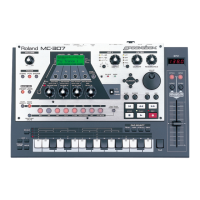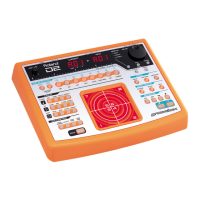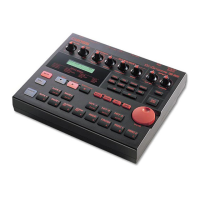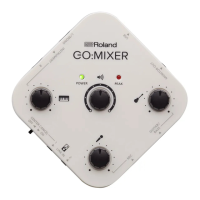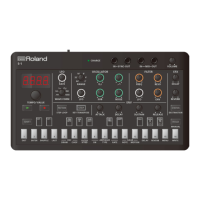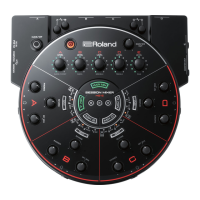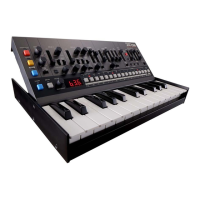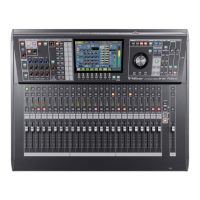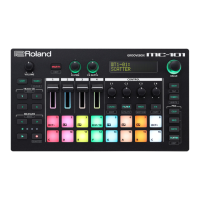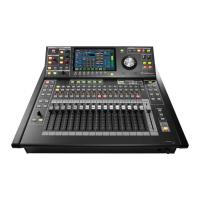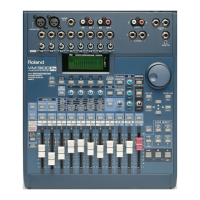73
Parameter List
MATRIX CONTROL
Ordinarily, if you wanted to change partial parameters using an
external MIDI device, you would need to send System Exclusive
messages-MIDI messages designed exclusively for the MC-707.
However, System Exclusive messages tend to be complicated, and the
amount of data that needs to be transmitted can get quite large.
For that reason, a number of the more typical of the MC-707’s partial
parameters have been designed so they accept the use of Control
Change (or other) MIDI messages for the purpose of making changes in
their values. This provides you with a variety of means of changing the
way tones are played.
For example, you can use the Modulation Bar to change the LFO cycle
rate, or use the keyboard’s touch to open and close a lter.
The function which allows you use MIDI messages to make these
changes in realtime to the partial parameters is called the “Matrix
Control.”
Up to four Matrix Controls can be used in a single tone.
To use Matrix Control, you specify which MIDI message (Source)
controls which parameter (Destination) and how deeply (Sens:
sensitivity).
Parameter Value Explanation
Source 1–4
(Matrix Control 1–4)
Sets the MIDI message used to change the partial parameter with
the Matrix Control.
OFF Matrix control will not be used.
CC01–31, CC33–95 Controller number 1–31, 33–95
BEND Pitch Bend
AFT Aftertouch
SYS-CTRL1–4
MIDI messages assigned by the SYSTEM
parameters SYS-CTRL 1–4
VELOCITY Velocity (pressure you press a key with)
KEYFOLLOW Keyfollow (keyboard position with C4 as 0)
TEMPO Tempo specied by the tempo assign source
LFO1, LFO2
LFO 1
LFO 2
PIT-ENV Pitch envelope
FLT-ENV Filter envelope
AMP-ENV Amp envelope
* Velocity and Keyfollow correspond to Note messages.
* Although there are no MIDI messages for LFO 1 through AMP Envelope,
they can be used as Matrix Control. In this case, you can change the partial
settings in realtime by playing tones.
* If you want to use common controllers for the entire MC-707, select “SYS-
CTRL1”–”SYS-CTRL4.” MIDI messages used as System Control 1–4 are set
with the Sys-CtrlSrc1–4 (p. 42).
NOTE
5
There are parameters that determine whether or not Pitch Bend,
Controller Number 11 (Expression) and Controller Number 64
(Hold 1) are received (p. 72). When these settings are “ON,”
and the MIDI messages are received, then when any change is
made in the settings of the desired parameter, the Pitch Bend,
Expression, and Hold 1 settings also change simultaneously. If
you want to change the targeted parameters only, then set these
to “OFF.”
5
There are parameters that let you specify whether specic MIDI
messages will be received for each part in a scene (p. 54).
When a tone with Matrix Control settings is assigned to a part,
conrm that any MIDI messages used for the Matrix Control will
be received. If the MC-707 is set up such that reception of MIDI
messages is disabled, then the Matrix Control will not function.
Destination 1–4
(MATRIX CONTROL 1–4)
Selects the partial parameter that is to be controlled when using the
Matrix Control. The following parameters can be controlled.
When not controlling parameters with the Matrix Control, set this to
“OFF.”
Up to four parameters can be specied for each Matrix Control, and
controlled simultaneously.
OFF Matrix control will not be used.
PCH Changes the pitch.
Parameter Value Explanation
Destination 1–4
(MATRIX CONTROL 1–4)
CUT Changes the cuto frequency.
RES
Emphasizes the overtones in the region of
the cuto frequency, adding character to the
sound.
LEV Changes the volume level.
PAN Changes the pan.
CHO Changes the amount of chorus.
REV Changes the amount of reverb.
PIT-LFO
Changes the vibrato depth.
PIT-LFO2
FLT-LFO1
Changes the wah depth.
FLT-LFO2
AMP-LFO1
Changes the tremolo depth.
AMP-LFO2
PAN-LFO1
Changes the eect that the LFO will have on
pan.
PAN-LFO2
LFO1-RATE Changes the speed of the LFO cycles. The
speed will not change if LFO Rate is set to
“note.”
LFO2-RATE
PIT-ATK Changes the Time 1 of the pitch envelope.
PIT-DCY
Changes the Time 2 and Env Time 3 of the
pitch envelope.
PIT-REL Changes the Time 4 of the pitch envelope.
FLT-ATK Changes the Time 1 of the FLT envelope.
FLT-DCY
Changes the Time 2 and Env Time 3 of the FLT
envelope.
FLT-REL Changes the Time 4 of the FLT envelope.
AMP-ATK Changes the Time 1 of the AMP envelope.
AMP-DCY
Changes the Time 2 and Env Time 3 of the
AMP envelope.
AMP-REL Changes the Time 4 of the AMP envelope.
PMT
If the Matrix Control is used to split partials,
set the PMT Velocity Control (p. 63) to “OFF.”
5
If the Matrix Control is used to split
partials, we recommend setting the Sens
(p. 74) to “+63.” Selecting a lower value
may prevent switching of the partials.
Furthermore, if you want to reverse the
eect, set the value to “-63.”
5
If you want to use matrix control to
switch smoothly between partials, use
the Velocity Fade Lower and Velocity Fade
Upper (p. 64). The higher the values set,
the smoother the switch is between the
partials.
FXM
Changing the depth of frequency modulation
produced by FXM
MFX-CTRL1
Applies a change to MFX CONTROL 1–4
Source. If this is specied for more than one
partial, the result will be the summed values.
MFX-CTRL2
MFX-CTRL3
MFX-CTRL4
PW Applies change to PW.
PWM Applies change to PWM.
FAT Applies change to FAT.
X-MOD
This setting is valid only for the carrier partial
(Partial 1 or 3), and applies change to the
CrossMod1-2Depth or CrossMod3-4Depth.
LFO1-STEP This is valid if the LFO1/LFO2 Waveform is
STEP; it species the step position. In this
case, the Sens value is ignored.
LFO2-STEP
SSAW-DETN
This is eective if OSC Type is SuperSAW; it
applies change to Super-SAW Detune.

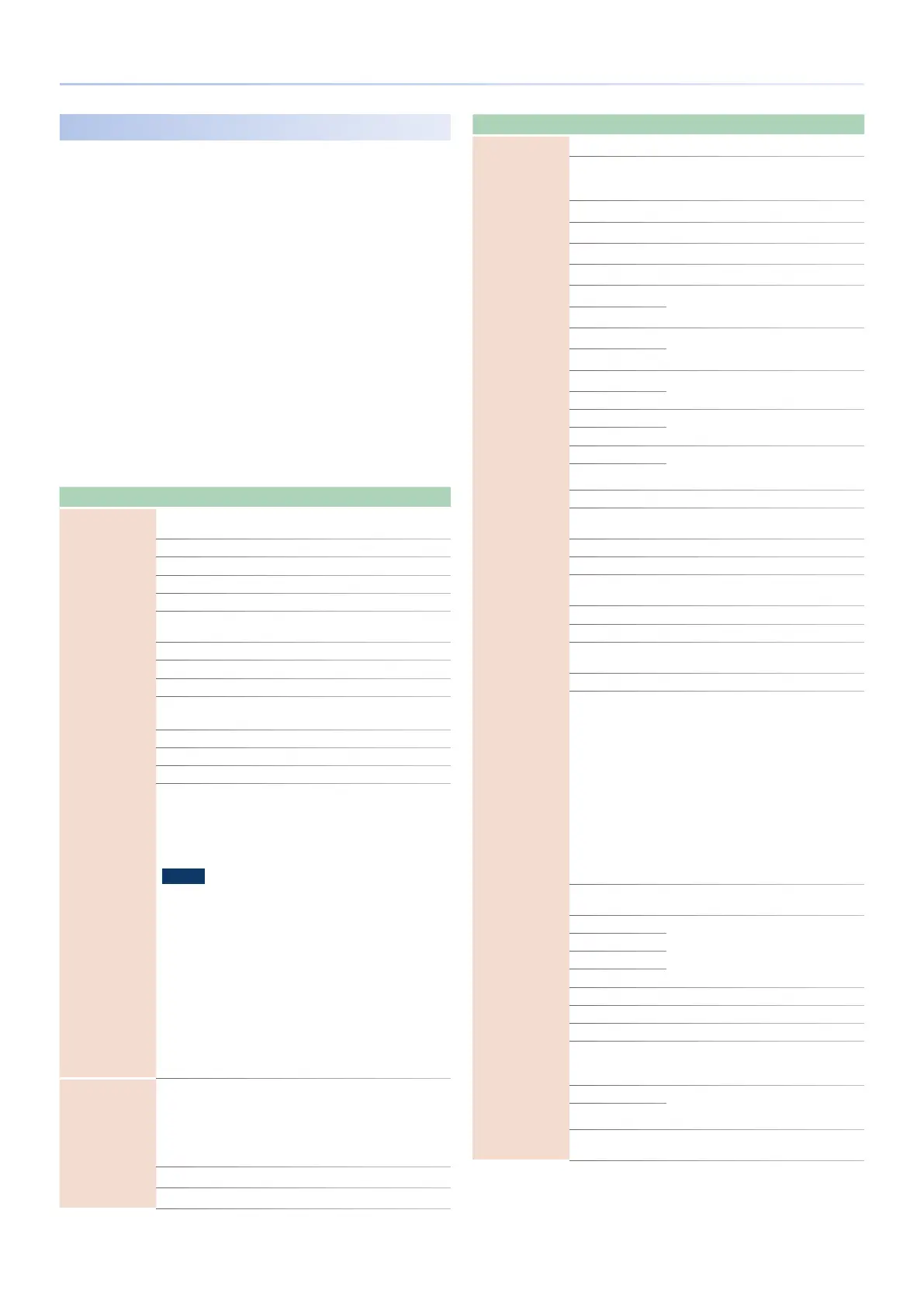